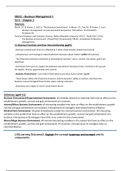EB121 – Business Management 1
SU 2 – Chapter 2
Sources:
Bosch, J.K. & Venter, E. (2011). ‘The Business Environment’, in Bosch, J.K., Tait, M., & Venter, E. (ed.)
Business management: an entrepreneurial perspective. 2nd edition. Port Elizabeth:
Prudentia SA.
Faculty of Business and Economic Science, Nelson Mandela University. (2017). ‘Study Unit 2 (Ch2)
The Business Environment’. [PowerPoint Presentation]. EB121: Introduction to Business
Management.
2.) Business Functions and their Interrelationship [pg39]:
- Business environment (micro) is affected by 2 other environments (market and macro)
- entrepreneurs and managers make/implement decisions about matters within the business
- The 8 Business functions contribute to attaining the business’ vision, mission, key values, goals and
objectives.
- Businesses form part of a larger international and national institution that is involved in the pursuit
for wealth, threats, opportunities and survival.
- Business Environment = sum total of international and local macro factors (pg40)
- These factors affect the 8 business functions and the business’ ability to achieve, therefore the
business cannot disregard these factors when making a decision.
- Businesses are subject to macro environment forces
Definitions [pg40-41]:
Business Environment/Organisational Environment: all variables (internal or external) that have an effect on the
establishment, growth, survival and goal achievement of a business.
Internal/Micro Business Environment: all interacting variables that have an effect on the establishment, growth,
survival and goal achievement of a business. Entrepreneurs & managers have direct/indirect influence.
Market/Task Environment: Situated immediately outside the internal business environment. All interacting
variables in the market that have an effect on the establishment, growth, survival and goal achievement of a
business. Entrepreneurs & managers have little to no control in this environment.
Macro/Mega Business Environment: All external interacting variables in the market that have an effect on the
establishment, growth, survival and goal achievement of a business. Entrepreneurs & managers have no
control/influence.
L/O(Learning Outcome)2: Explain the concept business environment and its
components.
, 3 Components of the Business Environment [pg 40]:
Business environment can be divided into two
environments; internal (micro) and external (market and
macro).
Q: Why do we study the business environments?
A: It has an effect on the establishment, growth
& survival of business. And it determines the field
of business activity and competitive business
strategies.
3.1 Variables of Internal/Micro Environment
Business activities, vision, mission, key values, goals
and objectives
Managing the 8 business Functions (general/strategic
managing, marketing, production, financial,
purchasing, human resources, information and
communication)
Access to FOP (natural resources, capital, human
resources, knowledge and entrepreneurship)
3.2 Variables of the Market Environment
S – Supplies; supply raw materials, semi-finished goods,
services and/or finance
C – Consumers; the market with purchasing power
I – Intermediaries; e.g. wholesalers and retailers
C – Competitors; already established in market and intend
to retain/improve their market share
C – Consumerism; organised movement by government,
consumers and businesses to improve rights and powers of
consumers.




